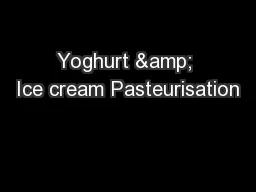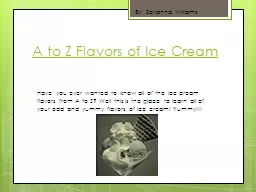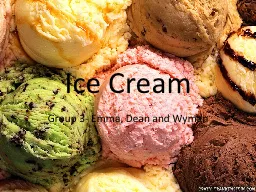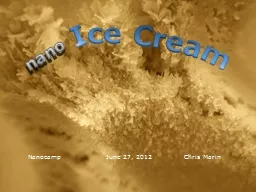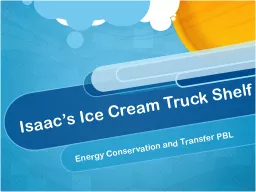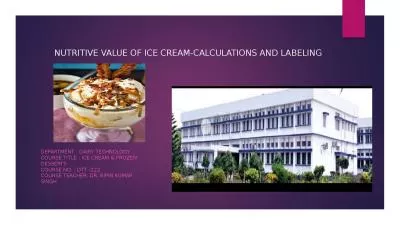PPT-Yoghurt & Ice cream Pasteurisation
Author : tatiana-dople | Published Date : 2018-07-03
Milk is heated to 72 0 C for 15 seconds It is then rapidly cooled to below 10 0 C This is continuous process is known as HTST Special plate heat exchangers has
Presentation Embed Code
Download Presentation
Download Presentation The PPT/PDF document "Yoghurt & Ice cream Pasteurisation" is the property of its rightful owner. Permission is granted to download and print the materials on this website for personal, non-commercial use only, and to display it on your personal computer provided you do not modify the materials and that you retain all copyright notices contained in the materials. By downloading content from our website, you accept the terms of this agreement.
Yoghurt & Ice cream Pasteurisation: Transcript
Milk is heated to 72 0 C for 15 seconds It is then rapidly cooled to below 10 0 C This is continuous process is known as HTST Special plate heat exchangers has milk on one side and steam on the other A special holding tube is used through which the milk passes to the cooling section and then to bottling. 6019520661 Flowood MS 6019922677 Clinton MS 6019248425 Byram MS 6013710101 Brandon MS 6018249990 Richland MS C. ream. Have you ever wanted to know all of the ice cream flavors from A to Z? Well this is the place to learn all of your odd and yummy flavors of ice cream. ! Yummy!!!. By: Serianna Williams. A is for Americone Dream. Group 3- Emma, Dean and Wyman. What is ice cream?. Ice cream is a frozen dairy product that comes in a wide range of flavours and colours. It’s used as a dessert, and to accompany things like pie and cake. This frozen product is enjoyed all over the world, but more so in America.. A History and How its made. History. Has been around since B.C. times.. Marco Polo returned to Italy with a sherbet recipe.. The first Ice Cream recipe was discovered in the 16. th. century.. Italy and England, were the first countries to discover Ice Cream. . nano. Nanocamp. June 27, 2012 Chris Marin . What is a liquid?. All liquids:. have a definite volume. conform to the shape of container. are not compressible. are made up of atoms that aren’t in fixed places. To add a case of . Gelato Gold Strawberries and Cream to your . order or to find a local supplier contact 01827 282571 or email . jo@suncreamdairies.com. . . Cases can be added to your existing mixed pallet order.. Energy Conservation and Transfer PBL. What’s the problem?. Isaac the Ice Cream Man is hoping to make more money this summer by having better customer service. He has noticed that it takes some customers a long time to count out their money, and some even drop their money or their ice cream. Isaac has decided to permanently install a narrow shelf on the outside of his service window so that customers can set their money and ice cream down while they are counting the correct amount. Isaac knows that ice cream can melt quickly, so he doesn’t want the shelf to cause any melting.. 2. Capturing Marketing Insights . – the internal environment. 2. The most. relevant . Strategic. Capabilities – a resource audit of . Danone. Yogurt UK . Factor. Trend. Implication . Evaluation. By: Wallace Stevens. Anthony Jandres. Nam Dang. Joel Hernandez. . The Emperor of. . Ice-Cream. Call the roller of big cigars,. The muscular one, and bid him whip. In kitchen cups concupiscent curds.. WEDNESDAY. THURSDAY. FRIDAY. SATURDAY. SUNDAY. Spreads. Jams and Marmalade. Honey. Marmite portions. Philadelphia Portions. Jams and Marmalade. Honey. Marmite portions. . Jams and Marmalade. Honey. What’s the first thought that comes to your mind when you hear the word “wrinkles”? For some, it might be “shock”, “horror” or “botox”, while for others, wrinkles are just another part of the natural aging process, and are gladly welcomes, because they show a life well lived, with lots of laughter and smiles. Wrinkles are creases and folds of the skin that develop as you age, and although its mostly common in older people, sun exposure, smoking, stress and lack of sleep can cause you to develop wrinkles earlier. They mainly occur on the face, neck, hands of our body, and are the result of lack of moisture and elasticity of the skin. Unfortunately, there’s no avoiding wrinkles; everyone develops them at some point in their life, and whether you love them or hate them, they are a part of you. If you’re not ready to face the wrinkles just yet, that’s ok too. A cellulite treatment cream or a sculpting cream can help firm your skin, and reduce the appearance of wrinkles. Most importantly, you might have to make some changes to your day-to-day routine. Extending shelf life . Food . may have . its . life extended if sufficient heat is applied to kill micro-organisms and inactivate the enzymes present in the . food.. There . are two main kinds of heat processing:. Suggest a asteroid name and flavor to ben and jerry's. asteroid. HED . meteorites. Iron . meteorites. Pallasite. Martian meteorites (. Chassigny). Elephant Moraine . 79001. Shergotty meteorite. Ice cream. Department : Dairy Technology. Course Title : Ice Cream & Frozen Desserts. Course No. : DTT -222. Course Teacher: Dr. Bipin Kumar Singh. Energy value. The energy value and nutrients of ice cream depend upon the food value of the ingredients from which it is made. Ice cream contains three or four times more fat, carbohydrate and 12-16 % more protein than does milk. In addition, it also contains other food products such as fruits, nuts, eggs, candies and sugar, which enhance its nutritive value. Ice cream is an excellent source of food energy, and fully 50% of its total solids content is sugar, including lactose, sucrose, and corn syrup solids. These constituents are almost completely assimilated and makes ice cream an especially desirable food for growing children..
Download Document
Here is the link to download the presentation.
"Yoghurt & Ice cream Pasteurisation"The content belongs to its owner. You may download and print it for personal use, without modification, and keep all copyright notices. By downloading, you agree to these terms.
Related Documents

